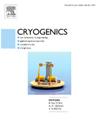Design and analysis of a HTS internally cooled cable for the Muon Collider target and capture solenoid magnets
IF 1.8
3区 工程技术
Q3 PHYSICS, APPLIED
引用次数: 0
Abstract
The Muon Collider is one of the options considered as the next step in High Energy Physics. It bears many challenges, last not least in superconducting magnet technology. The target and capture solenoid is one of them, a channel of approximately 18 m length consisting of co-axial solenoid magnets with a 1.2 m free bore and peak field on axis of 20 T. One of the main concerns come from the nuclear radiation environment that may influence the stable operation of the coil, as well as its material integrity. Energetic photons cause large radiation heat load, of the order of several kW in the cold mass, and deposit a considerable dose, several tens of MGy. Neutrons cause material damage, at the level of 10-3 DPA. These values are at the present limit of superconducting coil technology. We describe here the conceptual design of the target and capture solenoid, focusing on the HTS cable design, which is largely inspired by the VIPER concept developed at MIT. We show how to address margin and protection, cooling and mechanics specific to the HTS cable selected.
设计和分析用于 µ 子对撞机目标和捕获电磁铁的 HTS 内部冷却电缆
缪子对撞机是高能物理领域下一步发展的备选方案之一。它面临着许多挑战,尤其是超导磁体技术方面的挑战。目标和捕获螺线管就是其中之一,它是一个长约 18 米的通道,由同轴螺线管磁铁组成,自由孔径为 1.2 米,轴上的峰值磁场为 20 T。高能光子会造成巨大的辐射热负荷,在冷质量中的数量级为几千瓦,并沉积相当大的剂量,几十兆焦耳。中子会造成 10-3 DPA 的物质损伤。这些数值是目前超导线圈技术的极限。我们在此介绍目标和捕获螺线管的概念设计,重点是 HTS 电缆的设计,其灵感主要来自麻省理工学院开发的 VIPER 概念。我们展示了如何解决所选 HTS 电缆特有的裕度和保护、冷却和机械问题。
本文章由计算机程序翻译,如有差异,请以英文原文为准。
求助全文
约1分钟内获得全文
求助全文
来源期刊

Cryogenics
物理-热力学
CiteScore
3.80
自引率
9.50%
发文量
0
审稿时长
2.1 months
期刊介绍:
Cryogenics is the world''s leading journal focusing on all aspects of cryoengineering and cryogenics. Papers published in Cryogenics cover a wide variety of subjects in low temperature engineering and research. Among the areas covered are:
- Applications of superconductivity: magnets, electronics, devices
- Superconductors and their properties
- Properties of materials: metals, alloys, composites, polymers, insulations
- New applications of cryogenic technology to processes, devices, machinery
- Refrigeration and liquefaction technology
- Thermodynamics
- Fluid properties and fluid mechanics
- Heat transfer
- Thermometry and measurement science
- Cryogenics in medicine
- Cryoelectronics
 求助内容:
求助内容: 应助结果提醒方式:
应助结果提醒方式:


